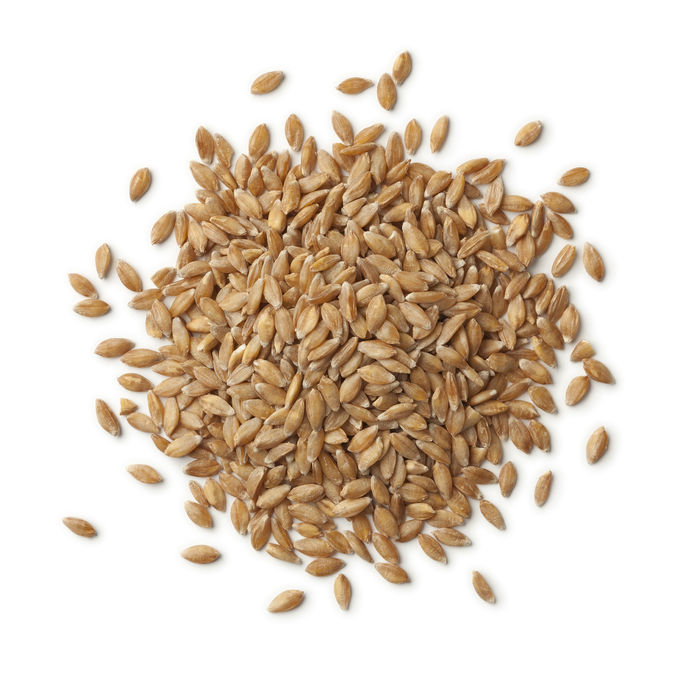
Einkorn
What is Einkorn?
Einkorn (Triticum monococcum) is a grain that has a single kernel per spikelet.1 Preferred over wheat due to its higher nutritional value, it can be ground into flour and used in bread making and other baked goods.
It is a close relative to wheat and durum. Unlike wheat, einkorn is diploid, meaning it has two complete sets of chromosomes inherited from each parent.2
Einkorn adds the following to products:3
- Yellow color
- Higher nutritional value
- Lower Volume
- Quicker mixing time

Origin
Einkhorn was grown in the Fertile Crescent area near Turkey over 10,000 years ago.2 It is thought to be one of the earliest cultivated grains that closely resembles wheat.4 It is currently grown in France, Morocco, and Turkey as animal feed or bulgur. This grain acquires one set of chromosomes from each parent leading to unlimited variability in the crop.3 This is challenging when consistency is needed to ensure a quality product such as bread.
Function
Einkorn can be milled into flour and used in baked goods. The resulting flour is similar to whole wheat flour. Due to the variability of einkorn lines, protein and gluten content are not consistent among the 25 flours tested for breadmaking.3
Nutrition
Einkorn has the following nutritional breakdown per 100g:2
- Energy (kJ): 1450
- Protein (g): 18.2
- Fat (g): 2.48
- Carbohydrate: (g) no data
- Fiber: (g) 8.7
- Sugars: (g) 2.67
- Starch: (g) 65.5
- Vitamins
- Thiamin: (mg) 0.5
- Riboflavin: (mg) 0.45
- Niacin: (mg) 3.1
- Vitamin B-6: (mg) 0.49
- Minerals
- Iron: (mg) 4.59
- Phosphorus: (mg) 415
- Potassium: (mg) 390
- Zinc: (mg) 2.24
- Manganese: (mg) 4.4
- Selenium: (mg) 27.89
Application
Einkorn is used in the same way as regular whole wheat flour. When it is used as flour in some recipes, the liquid might need to be reduced by roughly 15-20%.4
Caution should be given to the mixing process as over mixing can easily happen due to its lower gluten quality compared to traditional wheat flour.
Bread dough made with einkorn may be very sticky, and cake batters can get gummy.4
FDA regulation
The USDA classifies einkorn as species wheat more commonly used as animal feed.5
The FDA provides specific guidelines for labeling major food allergens. Since einkorn is in the same species as wheat (Triticum), it is listed in regulation F11. Section 201(qq) of the FD&C Act to be listed as a major food allergen.6
References
- “Triticum Monococcum » Einkorn.com.” Einkorn.com, 12 Jan. 2012, www.einkorn.com/triticum-monococcum/.
- Hidalgo, A, and Brandolini, A. “Nutritional properties of einkorn wheat ( Triticum monococcum L.).” Journal of the Science of Food and Agriculture 94.4 (2014). pp. 601-612.
- Borghi B. et al. Breadmaking Quality of Einkorn Wheat (Titicum monococcum ssp. Monococcum). Cereal Chem 73.2 (1996). pp. 208-214. https://www.aaccnet.org/publications/cc/backissues/1996/Documents/73_208.pdf
- “Baking with Einkorn.” Jovial Foods, Inc., jovialfoods.com/einkorn/baking-with-einkorn/.
- “United States Department of Agriculture.” Grain Inspection, Packers & Stockyards Administration, 20 Jan. 2012, www.gipsa.usda.gov/fgis/commgallery/gr_einkorn.aspx.
- Center for Food Safety and Applied Nutrition. “Labeling & Nutrition – Guidance for Industry: Food Labeling Guide.” U S Food and Drug Administration Home Page, Center for Food Safety and Applied Nutrition, Jan. 2013, http://www.fda.gov/foodlabelingguide.

